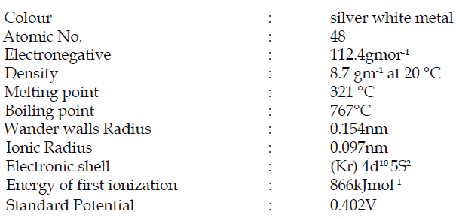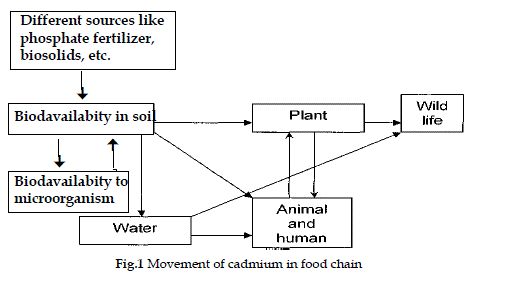Contamination of soil by heavy metals (Cd) is of widespread occurrence as a result of human agriculture and industrial activities. Cd induced reduction in the number of flowers and in vitro pollen germination but did not affect pollen viability. However it stimulated tube growth, decreased number of ovules/pistil (ovules were morphologically normal and receptive), inhibited number of pods, seeds, seed weight/ plant and 100 seed weight. Cd treatment did not affect starch content but increase protein content in physiologically mature seed. Significant yield reduction was obtained only in Alfisol and Ultisol amended with higher rate of Cd- enriched sewage sludge/city compost. The amount of cadmium in leachates remained more or less similar to the original values. The applied Cd remains in the top 10 cm soil (87-96%) and this resulted in lower recovery of heavy metals in the leachates (Cd 8.3%).
Keywords |
| Cadmium pollution, Sewage sludge, City compost, Food chain |
INTRODUCTION |
| The importance of Cadmium is that it is toxic and carcinogenic elements,
which occur widely in the environment both from natural and anthropogenic
sources, nearly ubiquitous in the environment, which is hazardious to human
and ecosystem in excessive amount. Inputs are mainly from atmospheric
deposition, application of biosolids, use of phosphates fertilizer, and from
effluents from cadmium using and recycling industries. |
Position in the periodic table |
| Cadmium (atomic number 48, atomic mass 112.40) has on outer electronic
configuration of 4d105S2 and belongs to II B group of the periodic table. In soil the ionic form of cadmium, which is absorbed by the plants, are Cd+2 ion and
Cd+4 ion. Plant easily absorbed Cd+2 ion as compared to Cd+4 ion because less
energy is required for absorption of Cd+2 as compared to Cd+4. Some other
important properties are given below: |
| |
 |
Environmental cadmium in Food chain |
| Soil- plant transfer of Cd both soil and plant properties is considered. Fig. 1
shows that Soil supply parameters like soil-Cd concentration, partitioning
of Cd between solid and solution phases affect the availability of Cd in soil,
likewise soil characteristics eg. Soil acidity. Cd is most moveable in acid soil,
presence of competing ions e.g. Clay type content and amount of organic
matters, these matter helping in Cd-fixation. Similarly plant demand parameter,
like presence of competing ions (Cd, H, Zn) in solution e.g. Deficiency
of Zn in particular may lead to high Cd accumulation and soil fertility make
Cd more available to plant and microorganism. |
| Bio-availability of Cd to soil microorganism is also depend on soil factor
however less study has been done in the concern but soil factor like fertility
is favorable to micro organism, Cd is found available to microorganism and
after their death, Cd become available to plants. |
| Plant transfers the Cd towards wild animal, human. Direct injection of soil
by human may also be significant exposure pathway in highly polluted soil
eg. Geophagy by children. |
| Direct and indirect
sources of Cd into
aquatic environment
including atmospheric
deposition erosion and
other means of mobilization
from soil, runoff,
waste water effluents
and P-fertilizer and
manures contributes
the Cd leaching from
soil after deposition of
Cd entry into water.
The contribution from
leaching from soil after
deposition of Cd on
the soil surface seems
essential. This is true
where ground water
is close to the surface
and/or where soil as
in coarse -grained,
shallow soils with low
organic composition. |
Plant uptake of Cadmium |
| Cadmium concentration
in normal plants
ranged from 0.1 -2.4
ppm (Alloway 1990),
but at higher concentration
it has been
shown to affect plant
growth and dry matter
yield adversely
(Bingham et al. 1976).
Green house pot culture
experiments were
conducted to evaluate
the uptake of cadmium
by maize crop from
increasing level of
Cd- enriched sewage
-sludge and city compost
amended Ultisol,
Alfisol, Entisol, and
Vertisol. In general,
significant yield reduction of maize shoots was obtained only in Ultisol, and Alfisol amended with
higher rates of Cd- enriched sewage-sludge/city compost. Results further
suggest that care has to be taken while amending soil (acid soil in particular)
with sewage- sludge and city compost containing high amount of Cd (Table 1). |
| Cd induced numbers of flowers and in vitro pollen germination but did
not affect pollen viability. However, it stimulated tube growth although did
not affect pistil length, it decreased number of ovules/pistil. Ovules were
morphologically normal and receptive. Cadmium inhibited number of pods,
seeds and seed weight. Cd treatment did not affect starch content but increase
protein content in physiologically mature seeds. Accumulation of Cd2+ was
maximum in the roots and least in the seeds (Table 3). |
| Eight forage species belonging to the leguminocae and graminae families were grown in pots in a coarse textured soil treated with different quantities
of Cd concentration tested i.e. 1 and 2.5 mg Cd kg-1 soil, most species exhibited
significant reduction in plant growth, measured as dry matter yields. Forage
species belonging to the Graminae family (Table 2). |
| For plant species like soybean and wheat, Cd toxicity was observed at
25 % yield reduction have been reported for spinach, soybean, curelycress,
lettuce, corn, carrot and turnip at Cd addition level of 4, 5, 8,13, 18, 20 and 28
mg kg-1 soil, respectively (Bingham et al. 1975). |
Conclusion |
| Cadmium is a toxic and carcinogenic metal, nearly ubiquitous in the environment,
which is hazardous to human and ecosystems in excessive amounts.
Inputs are mainly from atmospheric depositions, application of bio-solids,
use of phosphates fertilizer, and effluents from cadmium using and recycling
industries. Cd induced reduction in the number of flowers and in vitro pollen
germination, it stimulated tube growth, decreased number of ovules/pistil
(ovules were morphologically normal and receptive), inhibited number of
pods, seeds, seed weight/ plant and 100 seed weight, Cd treatment increase
protein content in physiologically mature seed. Significant yield reduction was
obtained only in Alfisol and ultisol amended with higher rate of Cd- enriched
sewage sludge/city compost. |
| The amount of cadmium in leachates remained more or less similar to the
original values. The applied Cd remains in the top 10 cm soil (87-96%) and
this resulted in lower recovery of heavy metals in the leachates (Cd 8.3%). |
Tables at a glance |
 |
 |
 |
 |
 |
| Table 1 |
Table 2 |
Table 3 |
Table 4 |
Table 5 |
|
| |
Figures at a glance |
 |
| Figure 1 |
|
| |
References |
- Alloway, B.J. 1990. Heavy Metal in Soil. Blackie and Sons Ltd. (Publ), U.K.
- Bingham, FT., Page, A.L., Mehler, R.J. &Ganje, T.J. 1975. J.Eenvir.Qual. 4: 207;40 : 715.
- Kumar, Suresh and Dhingra, H.R.2005. Sexual reproduction and cadmium partitioning in two mungbean genotype rose in soils contaminated with cadmium. Indian J. Plant Physiol. 10 (2) : 151-157.
- Page, A.L., Bingham, FT. and Chang, A.C. 1981. In lepp, N.W.(ed) Effect of Heavy Metal on Plants. 77- 109. Ramchandran, V. and DâÂÂsouza, T.Z. 1999. Plant uptake of Cadmium, Zinc and Manganese from soils amended with increasing levels of Cd-enriched sewage-sludge and city compost. J. Indian Soc. soil Sci. 47 : 739-743. SCOPE website www.icsu-scope.org.
- Singh, S.P. and Nayak, V.K. 1999. Plant uptake of cadmium in selected forage species. J. Indian Soc. Soil Sci. 47 : 96-100.
|